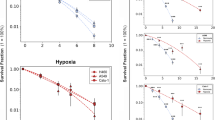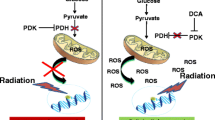Abstract
Lung cancer (LC) ranks as the most prevalent and deadliest cause of cancer death worldwide. Treatment options include surgery, chemotherapy and/or radiotherapy, depending on LC staging, without specific highlight. The aim was to evaluate the effects of X-radiation in three LC cell lines. H69, A549 and H1299 cell lines were cultured and irradiated with 0.5–60 Gy of X-radiation. Cell survival was evaluated by clonogenic assay. Cell death and the role of reactive oxygen species, mitochondrial membrane potential, BAX, BCL-2 and cell cycle were analyzed by flow cytometry. Total and phosphorylated P53 were assessed by western blotting. Ionizing radiation decreases cell proliferation and viability in a dose-, time- and cell line-dependent manner, inducing cell death preferentially by apoptosis with cell cycle arrest. These results may be related to differences in P53 expression and oxidative stress response. The results obtained indicate that sensibility and/or resistance to radiation may be dependent on molecular LC characteristics which could influence response to radiotherapy and treatment success.




Similar content being viewed by others
References
Dela CS, Cruz LT, Tanoue RA. Matthay, Lung cancer: epidemiology, etiology, and prevention. Clin Chest Med. 2011;32:605–44. doi:10.1016/j.ccm.2011.09.001.
Torre LA, Bray F, Siegel RL, Ferlay J, Lortet-Tieulent J, Jemal A. Global cancer statistics, 2012. CA Cancer J Clin. 2015;65:87–108. doi:10.3322/caac.21262.
Mendes F, Antunes C, Abrantes AM, Gonçalves A, Nobre-Gois I, Sarmento-Ribeiro AB, et al. Lung cancer: the immune system and radiation. Br J Biomed Sci. 2015;72:78–84.
Rosell R, Karachaliou N. Lung cancer in 2014: optimizing lung cancer treatment approaches. Nat Rev Clin Oncol. 2014;12(2014):75–6. doi:10.1038/nrclinonc.2014.225.
Verma V. Lung cancer: implementing lung-cancer screening-oncological “grey areas”. Nat Rev Clin Oncol. 2015;12:256–7. doi:10.1038/nrclinonc.2015.65.
Muaddi H, Chowdhury S, Vellanki R, Zamiara P, Koritzinsky M. Contributions of AMPK and p53 dependent signaling to radiation response in the presence of metformin. Radiother Oncol. 2013;108:446–50. doi:10.1016/j.radonc.2013.06.014.
Bieging KT, Mello SS, Attardi LD. Unravelling mechanisms of p53-mediated tumour suppression. Nat Rev Cancer. 2014;14:359–70. doi:10.1038/nrc3711.
Lee YS, Oh J-HH, Yoon S, Kwon M-SS, Song C-WW, Kim K-HH, et al. Differential gene expression profiles of radioresistant non-small-cell lung cancer cell lines established by fractionated irradiation: tumor protein p53-inducible protein 3 confers sensitivity to ionizing radiation. Int J Radiat Oncol Biol Phys. 2010;77:858–66. doi:10.1016/j.ijrobp.2009.12.076.
Stuschke M, Sak A, Wurm R, Sinn B, Wolf G, Stüben G, et al. Radiation-induced apoptosis in human non-small-cell lung cancer cell lines is secondary to cell-cycle progression beyond the G2-phase checkpoint. Int J Radiat Biol. 2002;78:807–19. doi:10.1080/0955300021014890.
Andreo P, Burns DT, Hohlfeld S, Huq MS, Kanai T, Laitano F, et al. Absorbed dose determination in external beam radiotherapy: an international code of practice for dosimetry based on standards of absorbed dose to water. Vienna: IAEA; 2011.
Gibbons JP. Monitor unit calculations for external photon and electron beams. In: AAPM annual meeting refresher course, Salt Lake City; 2001. p. 1–10.
Franken NAP, Rodermond HM, Stap J, Haveman J, van Bree C. Clonogenic assay of cells in vitro. Nat Protoc. 2006;1:2315–9. doi:10.1038/nprot.2006.339.
Abrantes AM, Serra MES, Gonçalves AC, Rio J, Oliveiros B, Laranjo M, et al. Hypoxia-induced redox alterations and their correlation with 99mTc-MIBI and 99mTc-HL-91 uptake in colon cancer cells. Nucl Med Biol. 2010;37:125–32. doi:10.1016/j.nucmedbio.2009.11.001.
Mamede AC, Pires AS, Abrantes AM, Tavares SD, Gonçalves AC, Casalta-Lopes JE, et al. Cytotoxicity of ascorbic acid in a human colorectal adenocarcinoma cell line (WiDr): in vitro and in vivo studies. Nutr Cancer. 2012;64:1049–57. doi:10.1080/01635581.2012.713539.
Serra AC, RochaGonsalves AMDA, Laranjo M, Abrantes AM, Gonçalves AC, Sarmento-Ribeiro AB, et al. Synthesis of new 2-galactosylthiazolidine-4-carboxylic acid amides. Antitumor evaluation against melanoma and breast cancer cells. Eur J Med Chem. 2012;53:398–402. doi:10.1016/j.ejmech.2012.04.003.
Sales TLF. Efeitos da radiação ionizante em linhas celulares de cancro do pulmão de não pequenas células: estudos in vitro. Coimbra: University of Coimbra; 2014.
Gonçalves AC, Alves V, Silva T, Carvalho C, De Oliveira CR, Sarmento-Ribeiro AB. Oxidative stress mediates apoptotic effects of ascorbate and dehydroascorbate in human Myelodysplasia cells in vitro. Toxicol Vitr. 2013;27:1542–9. doi:10.1016/j.tiv.2013.03.009.
Almeida S, Sarmento-ribeiro AB, Januário C, Rego AC, Oliveira CR. Evidence of apoptosis and mitochondrial abnormalities in peripheral blood cells of Huntington’ s disease patients. Biochem Biophys Res Commun. 2008;374:599–603. doi:10.1016/j.bbrc.2008.07.009.
Santos K, Laranjo M, Abrantes AM, Brito AF, Gonçalves C, Sarmento Ribeiro AB, et al. Targeting triple-negative breast cancer cells with 6,7-bis(hydroxymethyl)-1H,3H-pyrrolo[1,2-c]thiazoles. Eur J Med Chem. 2014;79:273–81. doi:10.1016/j.ejmech.2014.04.008.
Han JY, Chung YJ, Park SW, Kim JS, Rhyu MG, Kim HK, et al. The relationship between cisplatin-induced apoptosis and p53, bcl-2 and bax expression in human lung cancer cells. Korean J Intern Med. 1999;14:42–52.
Lien J-C, Huang C-C, Lu T-J, Tseng C-H, Sung P-J, Lee H-Z, et al. Naphthoquinone derivative PPE8 induces endoplasmic reticulum stress in p53 null H1299 cells. Oxid Med Cell Longev. 2015;2015:453679. doi:10.1155/2015/453679.
Würtzen PA, Pedersen LO, Poulsen HS, Claesson MH. Specific killing of P53 mutated tumor cell lines by a cross-reactive human HLA-A2-restricted P53-specific CTL line. Int J Cancer. 2001;93:855–61.
Balça-Silva J, Neves SS, Gonçalves AC, Abrantes AM, Casalta-Lopes J, Botelho MF, et al. Effect of miR-34b overexpression on the radiosensitivity of non-small cell lung cancer cell lines. Anticancer Res. 2012;32:1603–10.
Chen X, Liao C, Chu Q, Zhou G, Lin X, Li X, et al. Dissecting the molecular mechanism of ionizing radiation-induced tissue damage in the feather follicle. PLoS ONE. 2014;9:e89234. doi:10.1371/journal.pone.0089234.
Valko M, Rhodes CJ, Moncol J, Izakovic M, Mazur M. Free radicals, metals and antioxidants in oxidative stress-induced cancer. Chem Biol Interact. 2006;160:1–40. doi:10.1016/j.cbi.2005.12.009.
Thannickal VJ, Fanburg BL. Reactive oxygen species in cell signaling. Am J Physiol Lung Cell Mol Physiol. 2000;279:L1005–28. doi:10.1164/rccm.2206007.
Yamamori T, Yasui H, Yamazumi M, Wada Y, Nakamura Y, Nakamura H, et al. Ionizing radiation induces mitochondrial reactive oxygen species production accompanied by upregulation of mitochondrial electron transport chain function and mitochondrial content under control of the cell cycle checkpoint. Free Radic Biol Med. 2012;53:260–70. doi:10.1016/j.freeradbiomed.2012.04.033.
Montero J, Dutta C, van Bodegom D, Weinstock D, Letai A. p53 regulates a non-apoptotic death induced by ROS. Cell Death Differ. 2013;20:1465–74. doi:10.1038/cdd.2013.52.
Lao-Sirieix P, Brais R, Lovat L, Coleman N, Fitzgerald RC. Cell cycle phase abnormalities do not account for disordered proliferation in Barrett’s carcinogenesis. Neoplasia. 2004;6:751–60. doi:10.1593/neo.04280.
Gadhikar MA, Sciuto MR, Alves MVO, Pickering CR, Osman AA, Neskey DM, et al. Chk1/2 inhibition overcomes the cisplatin resistance of head and neck cancer cells secondary to the loss of functional p53. Mol Cancer Ther. 2013;12:1860–73. doi:10.1158/1535-7163.MCT-13-0157.
Yang L, Zhou Y, Li Y, Zhou J, Wu Y, Cui Y, et al. Mutations of p53 and KRAS activate NF-κB to promote chemoresistance and tumorigenesis via dysregulation of cell cycle and suppression of apoptosis in lung cancer cells. Cancer Lett. 2014;. doi:10.1016/j.canlet.2014.12.003.
Holbrook LAC, Butler RA, Cashon RE, Van Beneden RJ. Soft-shell clam (Mya arenaria) p53: a structural and functional comparison to human p53. Gene. 2009;433:81–7. doi:10.1016/j.gene.2008.11.029.
She QB, Bode AM, Ma WY, Chen NY, Dong Z. Resveratrol-induced activation of p53 and apoptosis is mediated by extracellular-signal-regulated protein kinases and p38 kinase. Cancer Res. 2001;61:1604–10.
Wu GS. The functional interactions between the p53 and MAPK signaling pathways. Cancer Biol Ther. 2004;3:156–61.
Henness S, Davey MW, Harvie RM, Davey RA. Fractionated irradiation of H69 small-cell lung cancer cells causes stable radiation and drug resistance with increased MRP1, MRP2, and topoisomerase IIalpha expression. Int J Radiat Oncol Biol Phys. 2002;54:895–902. doi:10.1016/S0360-3016(02)03037-7.
Frutuoso C, Silva M, Amaral N. Valor prognóstico das proteínas p53, C-erB-2 E Ki67 no carcinoma do ovário. Acta Med Port. 2001;14:277–83.
Sousa H, Santos AM, Pinto D, Medeiros R. Is there a biological plausability for p53 codon 72 polymorphism influence on cervical cancer development? Acta Med Port. 2011;24:127–34.
Fridman JS, Lowe SW. Control of apoptosis by p53. Oncogene. 2003;22:9030–40. doi:10.1038/sj.onc.1207116.
She Q, Bode AM, Ma W. Resveratrol-induced activation of p53 and apoptosis is mediated by extracellular-signal-regulated protein kinases and p38 kinase. 2001;1604–1610.
Duarte RLDM, Paschoal MEM. Marcadores moleculares no câncer de pulmão: papel prognóstico e sua relação com o tabagismo. J Bras Pneumol. 2006;32:56–65. doi:10.1590/S1806-37132006000100012.
Abrantes A. Hipóxia Tumoral - Metabonómica e Imagem, Estudo Experimental. Coimbra: University of Coimbra; 2013.
Acknowledgments
The authors would like to thank the Portuguese Foundation for Science and Technology for the award Portugal (Strategic Project PEst-C/SAU/UI3282/2013 and UID/NEU/04539/2013), COMPETE-FEDER.
Author information
Authors and Affiliations
Corresponding author
Ethics declarations
Conflict of interest
None.
Rights and permissions
About this article
Cite this article
Mendes, F., Sales, T., Domingues, C. et al. Effects of X-radiation on lung cancer cells: the interplay between oxidative stress and P53 levels. Med Oncol 32, 266 (2015). https://doi.org/10.1007/s12032-015-0712-x
Received:
Accepted:
Published:
DOI: https://doi.org/10.1007/s12032-015-0712-x




